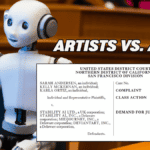Serial copyright plaintiffs beware: the discovery rule may not excuse late-filed infringement claims brought by “seasoned litigators.”
If you pay any attention to new copyright filings, you’re probably used to seeing the same names repeated over and over again as often as the refrain in a Daft Punk song. The copyright docket is filled with cases from serial plaintiffs with unassuming—if not outright ironic—names like Affordable Aerial Photography (“Half off statutory damages!”) and Charming Beats LLC (“We’ll serve you with a smile. . . and a summons.”) In fact, based on my simple Lex Machina query extensive research, the ten most prolific plaintiffs are responsible for a whopping 50% of the copyright cases filed in federal court over the past three years.

The overwhelming majority of these cases have been filed by adult entertainment studio Strike 3 Holdings, which keeps suing this guy named John Doe who apparently downloads an inordinate amount of internet porn. Another serial plaintiff is stock image agency Prepared Food Photos, which files lawsuits against people who download food porn. The bronze medal goes to Joe Hand Promotions, which targets bars that show pay-per-view boxing and UFC fights without a license. As far as the seven deadly sins of copyright defendants are concerned, the clear winners are lust, gluttony, and wrath. (Sloth and envy appear to be in a rebuilding phase.)

Nearly all of the cases filed by these copyright “frequent flyers” settle quickly, only to be replaced by new lawsuits in a never-ending circle of strife. But defendants who have the will (and the money) to fight back may have a new weapon in their arsenal, courtesy of the Southern District of New York.
Minden Pictures v. Complex Media
The case in point is a copyright lawsuit filed by Minden Pictures against Complex Media, which Judge Ronnie Abrams recently tossed on a motion to dismiss (read order here). Minden is a licensing agency that specializes in wildlife and nature photography. It’s also a frequent copyright litigant who’s filed more than 100 cases, including 66 in just the past three years. Minden’s complaints often tout that the company “works diligently to detect online infringements of its works” and that it engages technology companies to “crawl the internet” in search of unauthorized copies of Minden’s photos.
The photo at issue in Minden’s case against Complex was taken by photographer Gerry Ellis and depicts a troop of ring-tailed lemurs. Ellis took the photo in 2003 and registered it with the Copyright Office in 2008. In 2012, Complex used the photo in one of its articles but didn’t get a license from Minden.

In May 2022, Minden filed a copyright infringement lawsuit—nearly 10 years after Complex first posted the photo on its website. Complex then brought a motion to dismiss on the grounds that Minden’s lawsuit was barred by the Copyright Act’s three-year statute of limitations.
The “Discovery Rule”
In response to the motion to dismiss, Minden argued that under copyright’s so-called “discovery rule,” its infringement claim only began to accrue in March 2022, which is when Minden alleges it first discovered the photo on Complex’s website.
The discovery rule has had a bit of a moment lately, as federal circuit courts around the country have grappled with the question of whether a plaintiff who belatedly learns of an infringement may recover damages incurred more than three years prior to filing suit. In 2020’s Sohm v. Scholastic opinion, the Second Circuit held that even where the discovery rule applies, plaintiffs may only recover damages going back three years. In 2002, Sohm was heavily criticized by the Ninth Circuit in Starz v. MGM, which held that applying a three-year lookback period to damages “would eviscerate the discovery rule.” In February, the Eleventh Circuit weighed in, agreeing with the Ninth that so long as a plaintiff files suit within three years of discovering infringing acts, it may seek damages regardless of when those acts first occurred.
Under the discovery rule, an infringement claim does not “accrue” until the copyright holder discovers, or with due diligence should have discovered, the infringement.
Minden filed its lawsuit in the Southern District of New York, which is within the Second Circuit. That means that under Sohm, Minden’s damages would be limited to a three-year period even if the discovery rule applied. But in ruling on Complex’s motion to dismiss, the court found that Minden couldn’t take advantage of the discovery rule at all.
The “Seasoned Litigator”
Remember all those sophisticated infringement detection methods that Minden touted in its complaint? Well, they came back to bite it in the ring-tail. Judge Abrams wrote: “Given that Plaintiff’s business is designed to protect and enforce the copyrighted works that it licenses, and employs intricate means of doing so, it is not plausible that Plaintiff, in exercising reasonable diligence, would not have discovered the alleged infringing use here until nearly ten years after the infringement occurred.”
Note that Minden’s complaint didn’t provide any explanation for why the company didn’t or couldn’t, with the exercise of reasonable diligence, discover the alleged infringement any time between 2012 and 2022. And the court was quick to point out that during that period, Minden brought several lawsuits in which the work of the same photographer, Gerry Ellis, was at issue. Minden even filed an amended complaint after Complex brought its motion to dismiss, and still provided no explanation for its delay. While the court has given Minden one more chance to amend, it’s unclear whether the plaintiff will be able to plausibly or truthfully allege that it was unable to discover Complex’s alleged infringement earlier in light of its status as (in the court’s words) a “seasoned litigator” employing sophisticated infringement detection methods.
I should point out that the Ninth Circuit, which is typically a more plaintiff-friendly jurisdiction for copyright cases than the Second Circuit, recently reversed the decisions of two different district court judges who had decided the statute of limitations issue at the pleading stage. Both cases are unpublished, which means that they aren’t precedential, but they do show a willingness to allow even repeat plaintiffs to take advantage of the discovery rule where appropriate. For example, in Michael Grecco Prods. v. Ziff Davis, the panel noted that “whether. . . Google reverse image search technology would have captured the images is a question of fact, inappropriate for dismissal at the motion to dismiss stage.” The court suggested that, on remand, “the district court may order limited discovery that focuses on the statute of limitations question,” which would delay resolution of the issue to at least summary judgment.
The “Separate Accrual Rule”
Minden also asserted that, regardless of whether the discovery rule applied, its claim against Complex was not time-barred because of the so-called “separate accrual rule.” Under the separate accrual rule, a new limitations period begins to run separately for each new infringement. Here, Minden argued that every time Ellis’ lemur photo “was distributed from Defendant’s servers and transmitted to a user’s computer” a new claim of infringement arose.
Petrella v. MGM
The U.S. Supreme Court addressed the “separate accrual rule” for copyright claims in Petrella v. MGM, with the Court holding that “when a defendant commits successive violations, the statute of limitations runs separately from each violation. Each time an infringing work is reproduced or distributed, the infringer commits a new wrong. Each wrong gives rise to a discrete ‘claim’ that ‘accrue[s]’ at the time the wrong occurs.”
Petrella involved a dispute over the Martin Scorsese classic Raging Bull, which has been continuously released and re-released over the years on VHS, DVD, Laserdisc, Blu-ray, streaming, and countless other ways. (Gen Z readers: trust me when I say that there’s nothing quite like the feeling of buying the same movie you already own five times.) But in Petrella, the Court also made clear that “[s]eparately accruing harm should not be confused with harm from past violations that are continuing.” In Minden’s case, Complex published the lemur photo just once, in 2012, and the district court held that the mere fact that the photo remained online for the past 10 years doesn’t qualify as a new wrong to trigger the separate-accrual rule.
Continuing Online Presence
I’m not aware of any Circuit-level courts weighing in on this precise question, but most of the other district courts that have confronted the issue have agreed that an allegedly infringing work published on a defendant’s website doesn’t give rise to a separately accruing harm merely by remaining present on the internet.
“Separately accruing harm should not be confused with harm from past violations that are continuing.”
Petrella v. MGM, 572 U.S. 663 (2014)
I previously wrote about one of these cases involving the infamous “Winning Isn’t Normal” author Dr. Keith Bell, who’s racked up plenty of copyright plaintiff frequent flyer miles himself. In 2020, a district court in the Northern District of California ruled in favor of a nonprofit swim team that was sued by Bell for an allegedly-infringing Twitter post outside of the statute of limitations. Even though the tweet continued to remain online, the court dismissed Bell’s lawsuit and awarded the swim team $122,000 for successfully defending the claim. Other cases reaching similar results include Wolf v. Travolta and Color Image Apparel v. Jaeschke, which each found that there needs to be evidence that the defendant engaged in new affirmative acts of infringement to reset the limitations clock.
There is one outlier, APL Microscopic, LLC v. United States, which involved an allegedly infringing photo posted on NASA’s website. In that case, the Court of Federal Claims held that “each time a user viewed NASA’s webpage, APL’s copyrighted work was displayed on the user’s computer. Consequently, each of these displays constituted a separate infringement on APL’s right of public display.” But over the past few years, no other court has followed APL Microscopic. More recent cases, as typified by the new Minden Pictures decision, have held that the mere continued presence of allegedly-infringing material on a defendant’s website at best constitutes continuing harm from a past violation, not a new violation that restarts the limitations clock.
Because Minden’s complaint didn’t allege any allegedly infringing actions taken by Complex after posting Minden’s photo in 2010, Judge Abrams dismissed the case. As I noted above, Minden was given leave to amend, but unless it can plausibly allege that Complex committed some new affirmative infringing act with respect to its photo in the past three years, the dismissal is likely to stand.
Lixenberg v. Complex Media
Minden Pictures v. Complex Media is actually the second copyright lawsuit this year that Judge Abrams has dismissed based on the plaintiff’s status as a repeat player. In January, the court dismissed a case filed by Dana Ruth Lixenberg on similar grounds. Notably, the court in Lixenberg v. Complex Media found that the filing of fewer than twenty lawsuits since 2015 made the plaintiff (an individual photographer) a “seasoned litigator” who, with the exercise of reasonable diligence, should have discovered the alleged infringement earlier.
As in Minden Pictures, Judge Abrams gave the plaintiff an opportunity to amend her complaint. In an effort to distinguish herself from Minden, Lixenberg’s amended complaint pleads, among other things, that she doesn’t use reverse image software or other resources that would allow her to locate infringement of her photographs online. Complex has filed a second motion to dismiss, which is currently pending. In its new motion, Complex argues that Lixenberg was on inquiry notice, having filed multiple copyright infringement lawsuits involving the same image on the internet both before and after Complex posted her photo.
The Bottom Line
While a few cases don’t necessarily constitute a trend, the current takeaway from the recent decisions in this area is that, at least within the Second Circuit, so-called “seasoned litigators” may be held to a higher standard than other copyright plaintiffs, especially if they use sophisticated methods to detect infringing images, work “diligently to detect online infringements,” and enlist technology companies to “crawl the internet” to identify infringing uses of their works.
What do you think? Should plaintiffs who file multiple copyright cases be held to a higher standard? Let me know in the comments below or on social media @copyrightlately. I’ll keep you posted on new developments in this area. In the meantime, here’s a lemur-free copy of the decision in Minden Pictures v. Complex Media.
View Fullscreen






3 comments
Aaron, as tantalizing as it is to view this through the lens of limiting multiple filers qua “seasoned litigators,” I think these results are consistent with the longstanding reasoning of the discovery and separate accrual rules. The Court did make categorical presumptions based upon status as a frequent flier, but the presumptions fit into the discovery and accrual rule schemes. Putting aside the bad policy that I believe to be represented by Sohm, in contrast to MGM/Starz, the discovery rule in any litigation context is fact driven. Nothing in Minden seems to change the basics of the discovery or separate accrual rules.
Hi Greg – I agree that the discovery rule is typically fact driven, which is why I think its significant that Judge Abrams is specifically pushing back on repeat players and requiring more from them up front than a conclusory allegation that they didn’t or couldn’t have discovered the infringement earlier. That will probably fly in most cases, but perhaps not for serial litigants. This could also be seen as part of a larger trend I’ve written about before, with judges (especially in the S.D.N.Y.) pushing back against plaintiffs that they believe may be using the court to support a business model that’s more about revenue generation than it is about vindicating legal rights.
https://copyrightlately.com/are-courts-finally-getting-fed-up-with-copyright-shakedowns/
We’ve got an update! https://ww3.ca2.uscourts.gov/decisions/isysquery/0b287eaf-1538-45ed-ac09-ad8a7b285238/3/doc/23-1078_opn.pdf